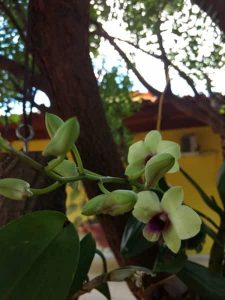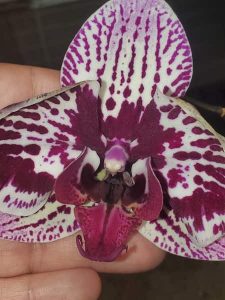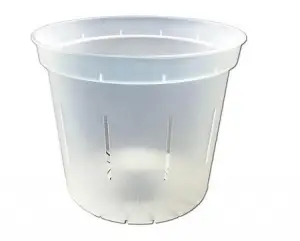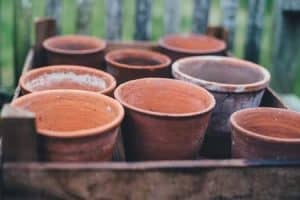Clear plastic pots seem to be the preference when growing orchids. But does it really make a difference? To determine if the pot makes a difference in growing orchids, I put together a comparison and weighed out the factoring determinants of whether clear plastic pots were the best choice for the orchid.
What are the best pots for Phalaenopsis orchids?
Clear plastic pots with large drainage holes or slots are the best for Phalaenopsis orchids, inducing healthier orchid roots. Healthy roots mean a healthy orchid. Other pots had negative factors that weighed down their ranking. Terracota, ceramic pots, and wooden-slatted containers all had negative influences, which in the long run, hindered orchid growth.

To better understand why this happens, think about how orchids grow in nature. The orchid (epiphytes) attaches itself ⅓ up the height of the tree trunk in order to get fresh air, adequate sunlight, and abundant rainfall.
Since there is no soil in the tree bark, so it had to adapt to getting its nutrients through the air. To do this, it adapted its roots to also provide some photosynthesis from sunlight.
Humidity and moisture are kept tightly around the orchid by the closing canopy of leaves above it. High temperatures promote evaporation from the soil under it. The orchid is in its biome surrounded by air, light, humidity, and water, and clear plastic pots provide the best resemblance to the orchid’s natural habitat.
What to Look for in Selecting Your Orchid Pot
Size – Don’t Overdo the Size
Do orchids need bigger pots?
A Phalaenopsis orchid pot needs to be large enough to grow one 1 inch (2.5 cm) in the coming year. For a faster-growing orchid or a sympodial orchid, you can add two inches for each pot. A miniature orchid can stay in the same size pot, just refresh the potting medium.
The pot has to imitate Goldilocks to an extent. It can’t be too big…or too small; the pot has to be just the right size. The roots in the pot need to be tight, but with room to grow. An over-packed potting medium will suffocate the roots, and a pot that is larger than necessary will make the orchid feel “insecure”, while it desperately looks for a side of the pot to grab onto.
Imagine the pot like tucking a small child into bed. The covers need to be tucked in all around them so they feel safe, but they still have to have some wiggle room to move their toes. This tight, safe, and secure feeling comes from the right sized pot. The room to grow means the roots aren’t jammed up around the sides of the pot but have about an inch to grow.
Every time you repot, make sure you only go up in size a pot 1 inch larger than the initial pot. This also helps the orchid know that the sides are there, and they aren’t floating around aimlessly in the pot.
Ventilation – Keep the Air Flowing
Why do orchids need pots with holes? Ventilated orchid pots with slots, holes, and slits in the side are a necessity for proper air circulation for orchid roots.
Pots that are totally confined will not work. Orchid roots are mostly areal in nature. They adapt into the potting medium just to have something to hang onto, providing stability. Slits in the side of the pot allow air to freely enter the pot, remove the extra humidity, and keep fungus away from the roots.
Drainage – Keep the Water Flowing
Do orchids need pots with drainage holes?
Since orchids need to be watered differently than houseplants, they need pots with large drainage holes, allowing water to exit quickly.
Drainage is probably the most important item to think of when considering orchid pots. If you do want a closed bottom pot, select a terrarium set-up and don’t water the orchid, but close the terrarium and create a separate biome with active mist.

Since this isn’t the case that most of us are going for, select a pot with more than enough slits, slats, holes, and slates to allow water to drain.
Why Clear Plastic was the 1st place
Do orchids need special pots? The best pots for orchids need to be made for orchids, since houseplants don’t need ventilation, allow for light to penetrate the material, and have large drainage holes. In this sense, orchids need special pots.
The secret to keeping an orchid happy is providing adequate growth for the roots. To stuff an orchid into a suffocating, dark, dry container and expect it to be happy is asking a lot. The main reason clear plastic is the number one choice for orchids is because sunlight can penetrate the pot, and orchid roots can aid in photosynthesis along with the leaves.
Clear plastic not only helps the orchid, it aids the grower, too. In most household plants, you can judge the orchid by the leaves. With an orchid, the health is judged by the roots. Clear plastic is an easy way to see if the roots need watering or if they are dry. Transparent materials also aid in judging whether the orchid needs repotted or not.

Many orchid growers keep their orchid double-potted. They maintain the orchid in a smaller, clear, plastic pot with abundant slits or holes, but to hide this, they place the orchid inside another pot, which is more decorative and exhibit-worthy.
This is a good way to keep the orchids that are not in bloom or the shelf of your study or office, while the orchid that is in bloom gets to be displayed on the living room table. The switch is easy, and stress-free. Just pull it out of the bigger pot, and return the orchid that has bloomed to the back shelf for its dormant period.
The only downside with double-potting is the time that the orchid is hidden in a dark pot. This, of course, will not aid in photosynthesis. Not all is lost. During the bloom, the orchid is not actively producing roots and growing new leaves. There is no need for the extra light (which means extra energy).
Actually, since the orchid is not actively doing anything besides showing off all it’s year’s effort in the flowers, you can lower—or cancel altogether—the fertilizer, too. Once the flowers fall off, you can return the orchid to the shelf it was growing on earlier, upgrade the fertilizer, and help the plant recuperate from blooming. This all translates to: clear pot.
Terracota Pots or Clay Pots: 2nd Runner-Up
TIP: If you’re looking for suggestions of orchid pots, this purchase (Affiliate Link)  is worthy of the price, since each pot comes out less than 2 dollars. For new orchid growers, it’s not always easy to decide on the size of pot you need to choose, so in this bundle, you get 2 pots in various sizes (3, 4, 5, and 6 inch pots), that fulfill every condition listed above.
is worthy of the price, since each pot comes out less than 2 dollars. For new orchid growers, it’s not always easy to decide on the size of pot you need to choose, so in this bundle, you get 2 pots in various sizes (3, 4, 5, and 6 inch pots), that fulfill every condition listed above.
They are from RepotMe, a reputable brand and sold on Amazon, so if you’re interested, click here (Affiliate Link) to see their description. Are terracotta pots good for orchids? Terracota pots are excellent for orchids since they maintain humidity and soak up extra water. On the other hand, if you have a heavy watering problem with orchids where you tend to over-water, the terracota pot will retain some of the humidity, and might not be the best option for you.Another positive side to clay pots is that they “breathe” better (when double-potted and if they had sufficient air holes).
to see their description. Are terracotta pots good for orchids? Terracota pots are excellent for orchids since they maintain humidity and soak up extra water. On the other hand, if you have a heavy watering problem with orchids where you tend to over-water, the terracota pot will retain some of the humidity, and might not be the best option for you.Another positive side to clay pots is that they “breathe” better (when double-potted and if they had sufficient air holes).
Airflow is actually aided in clay pots, since the surface interacts with the environment more than other materials, such as plastic.

If you have a heavy orchid with a long flowering spike, the clear plastic pot will fall over in time. The weight of the flower is just too much for the weak pot to handle, causing it to tip over. A terracota pot will keep the roots sturdy and since they are quite heavy themselves. Nothing is going to tip over the clay pot, unless it’s a cat, dog, or small child.
If you live in an excessively warm climate, using a clay pot is a simple trick that comes to your benefit. Clay will lower the temperatures inside the pot, keeping the area cool, dry, and with a cool draft of air circulating from its slots.
The down-side to clay pots is that the porous material in the clay will make the roots attach to it. When it come s to repotting, it’s almost impossible to remove the orchid without either breaking the pot or massively ripping off the velamen form the roots. This promotes more root damage than can be justified by all the former benefits.
Another downside is that since the terra-cota pot does retain more humidity if given too much water, the pot itself can mold. Given adequate time and no drying-out times, the pot will create the perfect place for bacteria to build up, which then calls mold colonies to come feast on the clay.
The last downside is that these pots are mostly handmade. This does raise their cost.
TIP: If you’re looking for suggestions of terracotta pots, this purchase (Affiliate Link from Amazon)  is excellent.
is excellent.
I suggest drilling a few holes in the side, just to make the pots more rustic-looking. Yet, for terracotta, you don’t need to do so since they are more breathable. In this bundle, you get 6 medium-sized pots (5 inch).
Don’t Stop Learning!
If you want to be included in more information and get a 14-page fertilization guide, please sign up for my newsletter. I don’t spam, but send emails out bi-monthly with some curious topics of interest. If you want more information, click here to go to a specific page on this website where I explain it more in detail.

Also, if you are looking for an orchid journal to keep your notes specifically about orchid care, check out my 2 solutions for that on this page. If note-keeping isn’t your thing, then there is a free excel spreadsheet that you can download. Click here for more information on how to do that.
If you subscribe to my newsletter, I will send you a 14-page guide on the main tips of orchid fertilizer. It is downloadable and you can print it out on your computer. I designed the guide to double up as a coloring book, just to make it fun.
Wooden-Slatted Containers: A Hefty 3rd Place
Are wooden pots good for orchids? The wooden containers, all though very decorative, have one major concern when dealing with orchids. With the constant watering, (usually once a week) the wood may break down. In a year, you’ll have to repot the potting medium and buy a new pot for your orchid. the picture below is one of many examples of this type of pot.
The second downside of this pot is that the slit in the sides may be a bit too big, and you can end up losing potting mix every time you water. A solution to this is using a wire mesh before adding any potting medium and completely cover the bottom.This way all the medium is held inside the mesh. If you don’t have wire mesh, you can substitute the plastic woven bags that grapefruit or oranges are sold in. This provides ample ventilation and still do their job quite well.
TIP: If you’re looking to purchase a wooden basket, there are several on Amazon that would work. In all honesty, I thought they were too small though. Only this one from Sun Bulb (Affiliate Link) was worth the price for an 8 inch basket.Now that you know all about picking the right orchid pot for the best occasion, it’s time to get your hands dirty. Check out some of the articles on using sphagnum moss as potting medium, or another article about adding charcoal to your pot. If you aren’t convinced that a clear, plastic pot is the best for orchids, try out a terrarium vase. In this article about orchid vases, I talk about the different kinds of glass pots for orchids.
was worth the price for an 8 inch basket.Now that you know all about picking the right orchid pot for the best occasion, it’s time to get your hands dirty. Check out some of the articles on using sphagnum moss as potting medium, or another article about adding charcoal to your pot. If you aren’t convinced that a clear, plastic pot is the best for orchids, try out a terrarium vase. In this article about orchid vases, I talk about the different kinds of glass pots for orchids.
If this information was of any help or clarified any doubts you had, please mention so in the comments. I love to interact with other orchid enthusiasts.
Share this page with a friend who has an orchid, comment, or give me a thumbs up 😊 in the comments below.
Happy cultivating!





Hi Amanda,
So happy I found your site. Thank you for all the good information. I am going to be repotting several of my Phalaenopsis orchids later this month. Will buy clear plastic pots from the company you have suggested. Usually I double pot my orchids already in plastic pots to keep them from tipping over. Do you have any suggestions on how to stop the plastic pots from tipping over besides double potting? Thanks
Hi Ann,
Thank you for your comment. It made my day. 🙂 Double potting orchids can be a problem sometimes. I usually do two things to avoid that:
1) I used to lay rocks on the opposite side that the orchid leans. This serves as a counterweight preventing the pot to topple over. For me, this soultion worked for a while. Once my cat found them, the damage by the fall was worse due to the weight.
2) Now I use short, fat decorative candles and snuggly prop them up on the side of the pot. This makes the shelf more elegant and also doesn’t hinder all the light since the candles are short. The pot still lets sun through on the back and inbetween the candles. For a bigger orchid, I can use 3 candles and they work fine. I have avoided double potting with this method. It also makes watering easier since I can lift the pots with ease. The rock method was a hassle. It worked, but took 2x the time.
-Amanda
Thank you! This article was helpful. I’m a newbie to Orchids. One was bought for me for my sons funeral and it died literally a month later. Now flash forward almost 2 years later and I now have 3 orchids and I broke the stem off of one of them but that same plant have new leaves growing, it’s so pretty! I repotted my medium orchid and I used a self watering pot, and it’s been in the new pot for about a month now and she’s blooming MORE flowers, which is awesome to watch grow on a daily basis. It’s so hard to find a orchid pot that’s glass instead of plastic or clay. I’ve looked online and the cheapest one I can find is $30 for a glass one. This one is heavy and so it the one that I broke the stem off of. So I repotted the larger one, and I’m searching for a orchid pot with holes throughout it. Does anyone make orchid pots and a self independent business? I enjoy shopping locally…..American made….Thank you again for the advice and I can’t wait to hear back from you!
Hi Stephanie,
I’m so glad your orchids are blooming! that is such a wonderful sensation. As for the vases, I don’t know any that are what you are describing. My suggestion would be to look on Etsy. They are mostly American but I can’t guarantee the prices. I have bought orchids from several vendors there, but never pots. If i find one, I’ll keep you posted.
-Amanda
Hi I am going to repot my orchid when it stops flowering .I found a large plastic lolly jar which I will cut to size and make holes for drainage .I also tried different places but the had out of a shop helped
Hi, I just bumped into this article. I want to repot an Odontoglossum orchid. Bought on a sale and it’s in a plain white plastic pot. Is this require transparent pot also, just as the Phalaenopsis orchids?
Thanks
Hi Snowdrop,
The transparency is best for 2 things: too see the roots so you know when they are in good health and to let light in so the roots can photosynthesize. If you have grown orchids before, and it sounds like you do, then you won’t need the transparent pots in order to see the root health. You’ll already have that down and know when to water. The second reason can be disregarded if you have a lot of light. The light on the leaves will be enough to keep the orchid alive. If your orchids are indoors and they don’t have enough lights, then the extra light on the roots helps a lot.
-Amanda
Hi Amanda
Just found you while looking for pots to repot some of my 12 Orchids.
Very helpful.
Many thanks
John (in the UK)
Hi John,
Thank you for your comment. I appreciate it.
-Amanda
Thank you for all the information. I’m new to orchids so any information is helpful.
I have my orchid and a glass fishing Bowl what do I do about drainage
Hi Amanda Great article Thanks! I about to report 12 Phalaenopsis orchids some I have had 2 yrs some just a month. I have ordered the clear plastic slotted for ventilation and drainage pots most 6 inch. I was planning on using the slotted terra Cotta orchid pots outside the plastic ones. Mine are kept on my patio shaded most of the day and are happy but definitely need attention and repotting! Your thoughts please. Thanks
Hi,
I know that you wrote this awhile ago, but I just found your article and wanted to thank you. I really appreciate your explanation about the clear pots (and suggestion for RepotMe containers) as well as figuring out sizing. I especially love your comparison to “tucking a small child into bed”!
This is by far the most helpful article that I have ever read about orchids!
Thank you for the usefuk information. I am wondering about the glazed slotted orchid pots .You don’t mention them.
This is the best article!!! Thank you for posting ALL this information. The best!
Thank you!